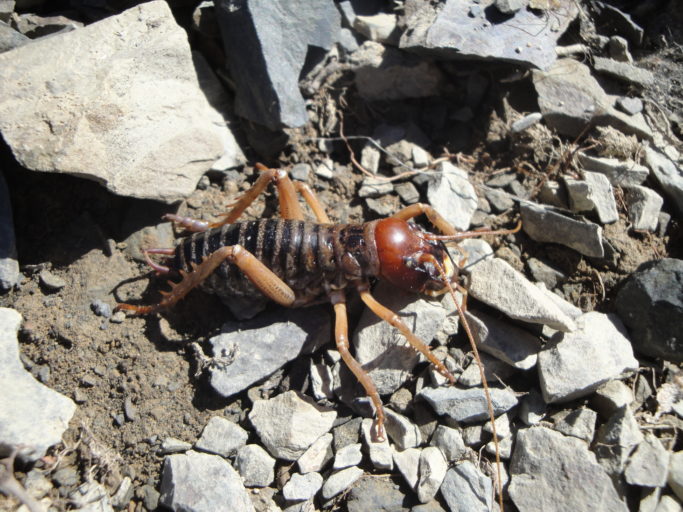What am I? I lie on my back and play dead with my legs in the air and jaws wide open to fool predators – and if that doesn’t work, I scratch, bite and vomit on them. I’m tough – so tough that when things get icy in my mountain home, my whole body can freeze down to -10°C for up to 17 days.

When the weather warms again, I thaw out and come back to life as good as new. And I come in two colours – yellow and black. One last clue: I’m only found in the South Island of New Zealand.
The answer is ‘mountain stone wētā’ (Hemideina maori), a large, flightless, nocturnal relative of grasshoppers that is endemic to New Zealand. Unlike other wētā, mountain stone wētā live in an alpine habitat and are found at altitudes of 1100 to 1500 metres above sea level on many mountain ranges in the Southern Alps.
Although they spend a lot of time on the ground in rock cavities, mountain stone wētā are actually a type of tree wētā, not ground wētā. It’s just that there are a lot more rocks than trees in their alpine homeland so they’ve adapted!
Their story gets weirder and weirder. But the ultimate is their cryogenic survival strategy – its so much more than mere hibernation. These guys freeze solid like something in a SciFi movie. So how do they do it?
Here’s what Wikipedia has to say:
“Mountain stone wētā can survive being frozen solid over winter and are estimated to be inactive for at least 5 months of the year. During winter H. maori are often immobile with ice crystals on their cuticle, when touched the individuals appear to be frozen solid. On warm days however, they can be found thawed and active under rocks. While the wētā are immobile they are in a state of suspended animation, they can survive up to 17 days in temperatures of about -10 °C.”
“At temperatures below -10 °C, approximately 85% of their body water is crystallized, one of the highest ice contents known for any animal.”
“During winter, their haemolymph (insect blood) contains low molecular weight cryoprotectants such as amino acids, especially proline and the disaccharide trehalose. These substances are synthesised during autumn and their concentration decreases again during spring and summer. The amino acids and sugars presumably help to decrease the ice content colligatively; however, they probably also have a direct protective effect on membranes and proteins via direct interaction or by modifying the water layer with the closest proximity to the molecules.”
So it’s a bit like having antifreeze in your blood, protecting your vital organs.
Mountain stone weta feed on plants and a few invertebrate species and apparently don’t move far during their lifetime. They use cavities under rock slabs (‘tors’) broken from schist outcrops as retreats during the day and are exposed to high winds and low temperatures all year round. Tors are separated by alpine meadows with no rocks. It’s assumed wētā aren’t found in the meadow areas, causing population fragmentation. They stay where the rocks are.
In spite of their harsh environment (or possibly because of it), mountain stone wētā are long-lived and may take 4 years or more to reach breeding maturity. Some individuals go on to survive at least 4 breeding seasons – making them at least 8 years old.
Males fight each other for access to females and some males show extreme ‘head weaponry’. These males have mandibles that tend to be two times longer and their head can be up to 1.5 times wider than those of females. A successful male mountain stone wētā will live with a harem of females – up to 7 females to a single male, giving him a much higher chance of mating success than his more solitary rivals.
Mountain stone wētā have been found from the Kaikoura Ranges south to the Rock and Pillar range in Otago. They’re widespread in the Southern Alps and therefore not considered to be at risk of extinction. Potential mammalian predators aren’t common where they live and native nocturnal predators of the mountain stone wētā are most likely to be reptiles such as geckos and skinks or birds such as ruru (morepork).
They don’t all live in the alpine zone however – there are at least two exceptions – island populations on Mou Waho Island and Mou Tapu Island, 2 of the 5 islands to be found in Lake Wanaka. Here, the species flourishes at an altitudinal range of just 300-475 metres above sea level – instead of their usual 1100-1500 metres. The first few weta possibly ‘rafted’ to the islands on floating logs and the population has grown over time.
Mou Waho Island is a predator-free reserve accessible by boat and has a jetty and walking tracks. It even has its own lake – with its own island – an island within a lake within an island within a lake… There’s lots of birdlife to see there, but if you do get to visit this beautiful spot, don’t just admire the birds. Keep an eye out for a very unique wētā – or perhaps a whole harem of them – sheltering amongst the schist.

